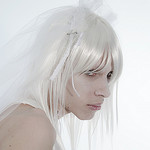Apparently people have had some serious problems distinguishing art from trash. It speaks highly of the profession, don't you think? Though I do wonder what possessed someone to clean an art piece.
I do so adore Ursula Vernon.
James Caprell does abstract right, even if it is occasionally a little commercial. Iva Gueorguieva, however, does it much much better. I was blown away when I saw her work in person.
A friend of mine introduced me to Zdzislaw Beksinski. Wonderful, wonderful.
Ana Teresa Fernandez creates surreal photorealistic oil paintings.
One of my exes very much adored James Jean, and I am glad he did not ruin my enjoyment of him.
The Illuminated Silmarillion. Or, for those more traditionally minded.
Some ridiculously over ornate pistols.
I remember first seeing video of Tim Hawkinson's Uberorgan some years ago, but was recently reminded of it.
I've known about Jen Stark for awhile now, even before she was internet famous, as she is a semi-local artist.
A strong series of work by a teenage girl out of tokyo.
Diana Al-Hadid is one of my favorite sculptors, and I have had the pleasure of hearing her lecture and seeing several of her pieces in person. She recently did a work with the USF Graphicstudio, which they talk a bit about here.
Here is a pretty intriguing photo project about familiar relations.
Adam Lewis does amazingly photorealistic 3-D renders.
Brent Stirton does some killer documentary photography.
Fascinating environmental paintings by Josh Keyes.
Ryan Shultz has a thing for drugs.
I want one of these.
Have I linked to Peter Callesen before?
God I wish I had the mind for detail that this man has. Along a similar vein is this.
This, on the other hand, is simply insane.
Diana Al-Hadid is one of my favorite sculptors, and I have had the pleasure of hearing her lecture and seeing several of her pieces in person. She recently did a work with the USF Graphicstudio, which they talk a bit about here.
Here is a pretty intriguing photo project about familiar relations.
Adam Lewis does amazingly photorealistic 3-D renders.
Brent Stirton does some killer documentary photography.
Fascinating environmental paintings by Josh Keyes.
Ryan Shultz has a thing for drugs.
I want one of these.
Have I linked to Peter Callesen before?
God I wish I had the mind for detail that this man has. Along a similar vein is this.
This, on the other hand, is simply insane.
Michael Ezra makes some particularly nice nude photography.
How to make cheap, quick and dirty, studio quality product shots.
Allan Mailland makes me miss working with wood. Something similar, but entirely different, is Jennifer Maestre.
Katsoyu Aoki produces incredible ceramics work.
Michihiro Matsuoka, on the other hand, makes an entirely different kind of sculpture.
A new toy from our friends at Wacom.
In case you didn't know of it.
And because everyone should be reminded now and then of Andy Goldsworthy.
This is fantastic. There is some 3-D wallpaper by Trenton Doyle at Graphicstudio, but it ain't got nuttin on this.
Some pretty rockin posters and illustration, and here as well, and here too.
How to make cheap, quick and dirty, studio quality product shots.
Allan Mailland makes me miss working with wood. Something similar, but entirely different, is Jennifer Maestre.
Katsoyu Aoki produces incredible ceramics work.
Michihiro Matsuoka, on the other hand, makes an entirely different kind of sculpture.
A new toy from our friends at Wacom.
In case you didn't know of it.
And because everyone should be reminded now and then of Andy Goldsworthy.
This is fantastic. There is some 3-D wallpaper by Trenton Doyle at Graphicstudio, but it ain't got nuttin on this.
Some pretty rockin posters and illustration, and here as well, and here too.
I
find it interesting that some people still stand staunchly that there
is a divide between "low art" and "high art" when I see any separation
dissolving rather quickly. See: Mike Mitchell.
The Heilbrunn Timeline of History is a simply amazing resource. Please do take a look at it.
I am honestly surprised sometimes that the Skull-A-Day project is still running.
Recently I was told that some of my photos had read as too "graphic", as if that were in an insult. The same has been said of my drawings as well. But I do find myself really inspired by works such as this.
Amy Shackleton paints images entirely without the use of a brush, preferring to pour it straight on the canvas - but not in the way you'd think.
Maybe I should have taken that class in underwater basket weaving...
Paul Chiappe does some great work. I am reminded of someone else, but the name escapes me...
The Heilbrunn Timeline of History is a simply amazing resource. Please do take a look at it.
I am honestly surprised sometimes that the Skull-A-Day project is still running.
Recently I was told that some of my photos had read as too "graphic", as if that were in an insult. The same has been said of my drawings as well. But I do find myself really inspired by works such as this.
Amy Shackleton paints images entirely without the use of a brush, preferring to pour it straight on the canvas - but not in the way you'd think.
Maybe I should have taken that class in underwater basket weaving...
Paul Chiappe does some great work. I am reminded of someone else, but the name escapes me...
I was originally going to just link to Jaime Pitarch, but really all of the featured artists are quite good.
I am not sure what this is, but I like it.
Is it wrong that I like this guy's sketchbook more than his illustration?
I want to know more about this artist.
Henry Justic Ford illustrated many of the fairy tale books I read as a child and has probably been a subconscious inspiration.
















